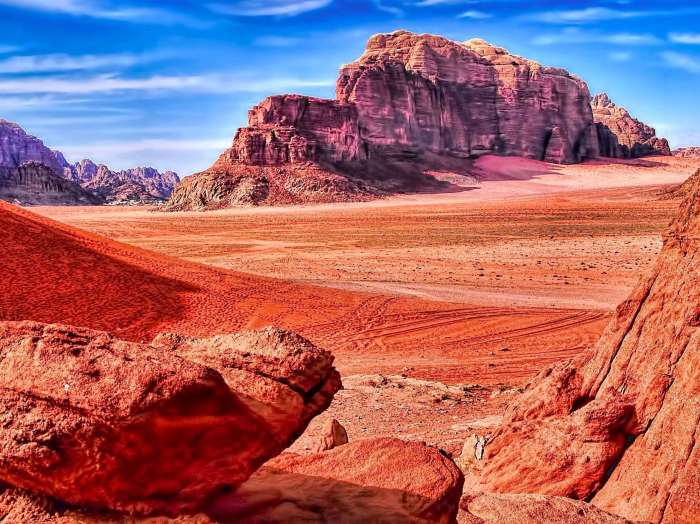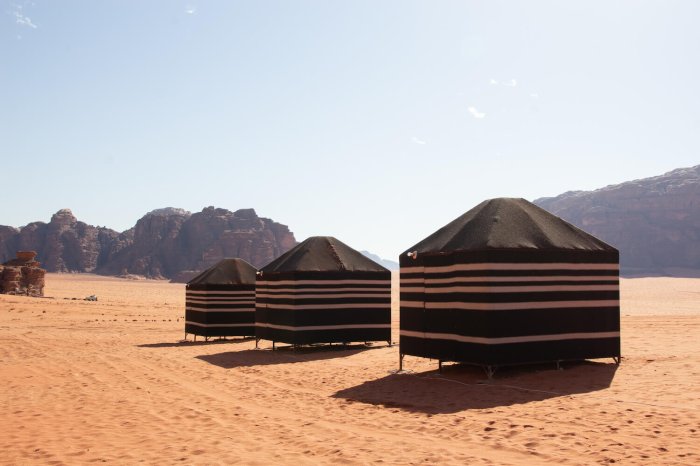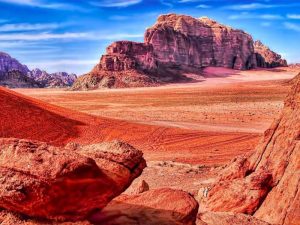
Journey into the heart of Wadi Rum, Jordan’s breathtaking desert landscape. This ancient land, sculpted by wind and time, offers an unparalleled adventure experience. From thrilling jeep tours across crimson sands to serene camel treks beneath a star-studded sky, Wadi Rum caters to every adventurer’s spirit. This exploration delves into the diverse expeditions available, highlighting their unique offerings and the sustainable practices ensuring this natural wonder remains pristine for generations to come.
We’ll examine the historical significance of Wadi Rum, its unique geological formations, and the array of activities on offer, from beginner-friendly walks to challenging climbs. We’ll also compare Wadi Rum to other global adventure destinations, showcasing its distinct advantages and the broader context of sustainable tourism within the adventure travel industry. Prepare to be captivated by the beauty and the adventure awaiting you in this extraordinary desert.
Wadi Rum Desert Expeditions
Wadi Rum, a protected desert reserve in southern Jordan, offers a breathtaking landscape and a wealth of opportunities for exploration and adventure. Its dramatic rock formations, towering sandstone mountains, and expansive sandy plains create a truly unique and unforgettable experience for visitors. This guide provides an overview of Wadi Rum desert expeditions, highlighting the region’s geological and historical significance, and outlining the various expedition options available to suit different experience levels.
Wadi Rum’s Geographical Features
Wadi Rum’s dramatic landscape is the result of millions of years of geological processes. Erosion by wind and water has sculpted the sandstone mountains into a stunning array of canyons, arches, bridges, and towering monoliths. These formations, often exhibiting vibrant hues of red, orange, and brown, are a testament to the power of nature. The vast expanse of sand dunes, contrasting sharply with the rocky outcrops, adds to the area’s visual complexity and offers opportunities for activities such as camel trekking and dune bashing.
The varied terrain, ranging from challenging climbs to relatively easy walking trails, makes it suitable for a range of fitness levels.
Wadi Rum’s Historical Significance
Wadi Rum has a rich and layered history, evidenced by the numerous Nabataean inscriptions and rock art found throughout the area. The Nabataeans, known for their sophisticated water management systems and impressive architecture, inhabited Wadi Rum for centuries, leaving behind a legacy of ancient settlements and intricate carvings. Later, the area served as a refuge for various nomadic tribes, and more recently, it has been the setting for several films, including the science fiction epic “The Martian.” This historical significance adds a cultural dimension to the natural beauty of the landscape, enriching the experience for visitors.
Available Wadi Rum Desert Expeditions
Wadi Rum offers a wide array of expeditions to cater to different preferences and experience levels. Choosing the right expedition depends on factors such as your fitness level, desired activity, and budget.
Before listing the expeditions, it’s important to note that many tour operators offer customized itineraries, so the options below are representative examples rather than an exhaustive list.
Beginner: These expeditions are suitable for those with limited experience in desert environments. They typically involve shorter treks, gentler terrains, and less physically demanding activities.
- Sunset camel ride and Bedouin dinner
- Short jeep tour highlighting key sights
- Guided walking tour of a smaller canyon
Intermediate: These expeditions offer a more challenging experience, involving longer treks, more rugged terrain, and potentially some rock climbing or scrambling.
- Multi-day camel trekking across the desert
- Jeep tour exploring remote canyons and rock formations
- Hiking to higher viewpoints with moderate elevation gain
Advanced: These expeditions are designed for experienced adventurers with excellent fitness levels and prior experience in challenging environments. They often involve significant physical exertion, technical skills, and potentially overnight camping in remote locations.
- Multi-day hiking and climbing expeditions
- Rock climbing and rappelling excursions
- Sandboarding and dune buggy adventures across challenging dunes
Comparison of Expedition Providers
The following table compares three hypothetical expedition providers. Note that prices and inclusions can vary significantly depending on the season, group size, and specific itinerary. Always check with the provider directly for the most up-to-date information.
| Expedition Provider | Price (USD) | Duration | Included Activities |
|---|---|---|---|
| Desert Adventures | $150 | Half-day | Jeep tour, sunset viewing |
| Rum Explorers | $300 | Full-day | Jeep tour, camel ride, Bedouin lunch |
| Wadi Rum Treks | $500 | 2 days/1 night | Camel trekking, camping, stargazing |
Activities Offered During Wadi Rum Expeditions
Wadi Rum offers a diverse range of activities catering to various interests and adventure levels. From leisurely camel treks to adrenaline-pumping jeep tours and challenging rock climbs, the desert provides an unparalleled playground for exploration and discovery. The unique landscape, steeped in history and natural beauty, enhances each experience, creating unforgettable memories for visitors.
Wadi Rum expeditions typically incorporate a selection of these activities, often tailored to the duration and preferences of the group. The combination of thrilling adventures and opportunities for quiet contemplation makes for a truly enriching experience. The stunning scenery, whether viewed from the back of a camel, the window of a jeep, or from a vantage point high on a rock face, is consistently breathtaking.
Sample Three-Day/Two-Night Wadi Rum Expedition Itinerary
This itinerary provides a balanced mix of activities, showcasing the diverse offerings of Wadi Rum. Adjustments can be made based on fitness levels and preferences.
Day 1: Arrive in Wadi Rum village, meet your guide, and embark on a camel trek through the desert. Enjoy the slow pace and breathtaking views as the sun sets, casting long shadows across the sandstone mountains. Dinner and overnight stay in a traditional Bedouin camp under the stars. (Estimated duration: 4-6 hours camel trek, including sunset viewing and camp setup).
Day 2: A morning jeep tour exploring the most iconic locations in Wadi Rum, including Khazali Canyon, Um Fruth Rock Bridge, and Lawrence’s Spring. Enjoy the thrill of off-road driving and the stunning vistas. Afternoon dedicated to rock climbing for those interested (optional activity, suitable for varying skill levels with experienced guides). Evening: Stargazing session with a Bedouin astronomer, learning about the constellations and local folklore.
Dinner and overnight stay at the Bedouin camp. (Estimated duration: 4-6 hours jeep tour, 2-4 hours rock climbing, 1-2 hours stargazing).
Day 3: Sunrise hike to a high viewpoint for panoramic views of the desert landscape. Enjoy breakfast with a view. Departure from Wadi Rum village. (Estimated duration: 2-3 hours hike, including breakfast).
Wadi Rum Landscapes
Wadi Rum’s landscape is characterized by towering sandstone mountains, dramatic canyons, vast expanses of sand, and ancient rock formations. The colors vary dramatically throughout the day, shifting from soft oranges and pinks at sunrise and sunset to deep reds and browns during the day. The contrast between the stark, rugged mountains and the delicate beauty of the desert flora is captivating.
Ancient Nabataean inscriptions and rock art add a layer of historical intrigue to the natural beauty. The vastness of the landscape evokes a sense of awe and solitude. The varied terrain offers opportunities for diverse activities, from gentle walks to challenging climbs.
Essential Equipment and Clothing Recommendations
Proper preparation is crucial for a comfortable and enjoyable Wadi Rum expedition.
It’s important to pack appropriate clothing and equipment to handle the desert environment’s extreme temperature variations. Comfortable, sturdy footwear is essential, as is protection from the sun’s intense rays.
- Lightweight, breathable clothing (long sleeves and pants recommended for sun protection)
- Sturdy hiking boots or shoes
- Wide-brimmed hat and sunglasses
- Sunscreen with a high SPF
- Water bottle (or hydration pack)
- Headlamp or flashlight
- Camera
- Binoculars (optional)
- Personal medications (if required)
Comparing Wadi Rum to Other Adventure Destinations
Wadi Rum, with its dramatic sandstone mountains, vast desert expanses, and ancient petroglyphs, offers a unique adventure experience. However, it’s important to understand how it compares to other popular desert destinations globally to appreciate its distinct characteristics and appeal to a wider range of adventure seekers. This comparison highlights Wadi Rum’s unique selling points and helps potential visitors make informed choices.Wadi Rum’s landscape, while undeniably desert, differs significantly from other arid regions.
Unlike the vast, often featureless sand seas of the Sahara, Wadi Rum boasts a more varied terrain, incorporating towering rock formations, narrow canyons, and hidden oases. This diverse landscape provides a richer and more visually stunning backdrop for adventure activities. Similarly, while deserts like the Atacama in Chile offer stark beauty, their geological features and ecological systems are quite different, resulting in distinct experiences.
Key Differences Between Wadi Rum Expeditions and Other Adventure Tourism Activities
Wadi Rum expeditions frequently integrate cultural elements into the adventure. Visitors aren’t simply traversing a landscape; they are engaging with a region that holds deep historical and Bedouin cultural significance. This contrasts with many other adventure tourism activities that may focus solely on physical challenges or the natural beauty of a location, without the same level of cultural immersion.
Secondly, the scale of the landscape itself is a key differentiator. The sheer immensity and dramatic scale of Wadi Rum’s rock formations create a sense of awe and wonder that is often lacking in smaller, more confined adventure settings. Finally, the relative accessibility of Wadi Rum’s various activities, from jeep tours to camel treks to rock climbing, makes it appealing to a broader range of fitness levels and experience.
Many other adventure destinations might require higher levels of physical fitness or specialized training.
Unique Selling Points of Wadi Rum Expeditions
Wadi Rum offers a unique blend of adventure and cultural immersion rarely found elsewhere. The Bedouin culture, deeply intertwined with the landscape, provides an authentic and enriching experience. Visitors can interact with local communities, learn about traditional Bedouin life, and enjoy authentic cuisine under the stars. This cultural aspect enhances the overall adventure experience, providing a deeper connection to the destination than simply engaging in physical activities.
Furthermore, the relatively untouched nature of Wadi Rum preserves a sense of wilderness and solitude often lost in more commercialized adventure destinations. This pristine environment contributes to a more authentic and immersive experience for visitors. Finally, the versatility of activities available caters to a broad spectrum of interests, from leisurely camel rides to challenging rock climbing, ensuring there’s something for everyone.
Alternative Adventure Travel Options
Many destinations offer similar adventure experiences, but with distinct characteristics. A list of alternatives helps potential visitors explore other options based on their specific preferences.
- The Sahara Desert (Morocco, Tunisia, Egypt): Offers vast sand dunes and traditional Berber culture, but generally lacks the varied rock formations and canyons of Wadi Rum.
- Atacama Desert (Chile): Known for its extreme aridity, unique geological formations, and stargazing opportunities, but offers a different type of desert landscape and cultural experience.
- Namib Desert (Namibia): Features towering sand dunes, unique flora and fauna, and opportunities for wildlife viewing, but lacks the same level of historical and cultural significance as Wadi Rum.
Environmental Impact and Sustainability of Wadi Rum Tourism

The increasing popularity of Wadi Rum as a tourist destination presents both opportunities and challenges. While tourism generates economic benefits for the local community, it also carries the potential for significant environmental impact, necessitating careful management and sustainable practices. Understanding these impacts and implementing effective strategies is crucial for preserving the unique beauty and ecological integrity of this remarkable landscape for future generations.The environmental impact of tourism in Wadi Rum is multifaceted.
Increased visitor numbers lead to greater pressure on fragile ecosystems. Off-road driving, even with guided tours, can cause soil erosion and habitat disruption. Waste generation, including litter and sewage, poses a threat to water sources and wildlife. The demand for resources, such as water and energy, associated with accommodation and visitor services can strain local supplies.
Light pollution from campsites and tourist facilities can also affect nocturnal wildlife. Furthermore, the potential for damage to ancient rock art and archaeological sites due to increased foot traffic needs careful consideration.
Sustainable Tourism Practices in Wadi Rum
Several sustainable tourism practices are currently employed in Wadi Rum to mitigate environmental damage. Many tour operators prioritize responsible off-road driving techniques, minimizing their impact on the delicate desert ecosystem. Waste management programs, including the implementation of designated waste disposal points and regular clean-up initiatives, are becoming more common. The promotion of eco-friendly accommodations, such as those using solar power and water conservation technologies, is gaining traction.
Educating tourists about responsible behavior, such as respecting the environment and minimizing their ecological footprint, is also crucial. Local Bedouin communities are increasingly involved in sustainable tourism initiatives, benefitting economically while actively participating in the preservation of their ancestral lands.
Minimizing Negative Environmental Impacts of Wadi Rum Expeditions
To further minimize the negative environmental impact, several strategies can be implemented. Stricter regulations on off-road driving, possibly including designated routes and speed limits, are needed. Investment in improved waste management infrastructure, including more frequent collection and proper disposal, is essential. Promoting the use of renewable energy sources in tourist facilities is vital for reducing carbon emissions.
Encouraging the use of reusable water bottles and reducing single-use plastics would significantly decrease waste. The development of well-maintained trails and designated visitor areas can help to concentrate visitor impact and protect sensitive areas. Furthermore, regular environmental monitoring programs are needed to track the effectiveness of implemented strategies and to identify emerging environmental challenges.
Promoting Eco-Friendly Tourism Practices Among Expedition Providers
A comprehensive plan for promoting eco-friendly tourism practices among expedition providers could involve several key components. This includes mandatory training programs for tour guides and expedition leaders on responsible tourism practices, covering topics such as waste management, minimizing environmental impact, and educating tourists. Incentivizing eco-friendly practices through awards and recognition programs can motivate providers to adopt sustainable operations.
The development of a clear set of environmental standards and certification programs for tour operators would ensure accountability and promote best practices. Collaboration with local communities and government agencies is crucial for coordinating efforts and implementing effective policies. Finally, transparent and accessible information for tourists on the environmental impact of different tour operators would empower consumers to make informed choices and support sustainable businesses.
Wadi Rum and Broader Tourism Trends
Wadi Rum’s burgeoning popularity reflects broader shifts in the adventure tourism sector. Its unique landscape and activities cater to a growing demand for authentic, immersive travel experiences, aligning with global trends towards sustainable and responsible tourism. This section explores Wadi Rum’s place within these trends, examining successful marketing strategies and integration into wider travel itineraries.Adventure tourism is experiencing a significant surge, driven by a desire for unique experiences and a shift away from mass tourism.
The trend is toward personalized, immersive journeys that prioritize sustainability and cultural sensitivity. Wadi Rum, with its stunning natural beauty and Bedouin culture, perfectly embodies this shift. The increasing popularity of experiential travel, emphasizing interaction with local communities and participation in authentic activities, is a key driver of Wadi Rum’s success. This contrasts with previous models of adventure tourism that often prioritized adrenaline-fueled activities over cultural immersion.
Successful Marketing Strategies for Wadi Rum Expeditions
Effective marketing for Wadi Rum expeditions leverages the destination’s unique selling points: its breathtaking landscape, the rich Bedouin culture, and the diverse range of activities offered. Social media platforms, particularly Instagram and YouTube, play a crucial role, showcasing stunning visuals and user-generated content. High-quality photography and videography are essential, emphasizing the raw beauty of the desert and the authenticity of the experiences.
Collaborations with travel influencers and bloggers generate significant reach and credibility. Furthermore, partnerships with international tour operators and travel agencies expand the reach to a wider global audience. Finally, targeted advertising campaigns on online travel platforms, highlighting specific niche interests like stargazing or jeep tours, further refine marketing efforts.
Integrating Wadi Rum into Larger Travel Packages
Wadi Rum’s appeal is significantly enhanced when integrated into broader Jordanian travel itineraries. This allows tourists to experience a variety of attractions within a single trip, maximizing value and providing a more comprehensive cultural experience. Successful integration strategies often combine Wadi Rum with visits to Petra, the Dead Sea, and Amman. Packages might include a multi-day itinerary encompassing all these locations, with transportation and accommodation thoughtfully arranged.
This approach caters to travelers seeking a diverse and enriching travel experience, enhancing the overall appeal of Wadi Rum as a key destination within a larger Jordanian adventure. For example, a seven-day itinerary might include three days exploring Petra, two days in Wadi Rum for various expeditions, and two days relaxing at the Dead Sea.
Religious Pilgrimages, Wildlife Watching, and Other Tourism Types

Wadi Rum’s stunning landscape and spiritual significance offer unique opportunities to diversify tourism beyond traditional adventure expeditions. Combining elements of faith-based travel, nature observation, and other niche interests can create attractive and sustainable tourism packages for a wider range of visitors.
Combining Wadi Rum Expeditions with Religious Pilgrimages in Jordan
Wadi Rum’s historical and geographical context can be interwoven with religious tourism itineraries in Jordan. The area holds significance for various faiths, offering opportunities to create unique pilgrimage experiences. For example, tours could incorporate visits to sites with historical connections to biblical narratives, linking Wadi Rum’s natural beauty with the spiritual journey. This could involve guided tours highlighting specific locations mentioned in religious texts, incorporating talks by religious scholars or historians, and offering moments of reflection within the awe-inspiring desert landscape.
Such a combination would attract a segment of religious tourists who seek both spiritual enrichment and adventure.
Wildlife Watching Opportunities in Wadi Rum Expeditions
While Wadi Rum is primarily known for its geological features, it supports a surprising array of desert wildlife. Incorporating wildlife watching into expeditions can enhance the overall experience. Nocturnal wildlife safaris, guided by experienced naturalists, could allow visitors to observe desert foxes, Arabian oryx (if reintroduction programs are successful and animals are visible), and various bird species adapted to the arid environment.
Daytime excursions could focus on identifying reptile and insect life, using binoculars and spotting scopes to enhance observation. Educational materials and talks could further enrich the wildlife watching experience, promoting awareness and conservation.
Winter Sports Related Activities in Wadi Rum
While Wadi Rum doesn’t offer traditional winter sports like skiing or snowboarding, the cooler winter months present opportunities for different activities. These could include hiking and trekking in the cooler temperatures, enjoying stargazing under clearer skies, and participating in desert camping experiences with the added attraction of cooler nighttime temperatures. Hot air balloon rides, offering unique perspectives of the landscape, could also be promoted as a winter activity.
The relatively calm winter winds may also make rock climbing and other adventurous activities more feasible.
Incorporating Diverse Tourism Types into a Broader Jordanian Travel Package
A broader Jordanian travel package incorporating a Wadi Rum expedition can appeal to a wider range of interests.Island Hopping: While Jordan doesn’t have islands, a package could combine a Wadi Rum experience with a visit to the Dead Sea, offering a stark contrast between desert and aquatic environments. This could involve floating in the Dead Sea and exploring its unique therapeutic properties, creating a memorable juxtaposition with the rugged Wadi Rum landscape.Voluntourism: Partnering with local conservation organizations, packages could include volunteering opportunities in Wadi Rum, such as assisting with environmental cleanup or contributing to reforestation efforts.
This provides a unique and meaningful experience for travellers, contributing directly to the region’s sustainability.Photography Tours: Wadi Rum’s dramatic landscapes offer unparalleled photographic opportunities. Specialized tours could be designed for photographers of all skill levels, focusing on specific techniques like astrophotography, landscape photography, or wildlife photography. These tours could include workshops and guided excursions to prime locations for capturing stunning images.Festival Travel: Timing a Wadi Rum expedition with local festivals or events could enrich the cultural experience.
This could involve participation in Bedouin cultural events or connecting with local celebrations, offering a glimpse into the region’s traditions and heritage.Underwater Adventures: Combining a Wadi Rum expedition with diving or snorkeling in the Red Sea (Aqaba) provides a diverse experience. This would highlight Jordan’s contrasting environments and offer opportunities for underwater exploration and marine life observation.Art and Architecture Tours: A Wadi Rum trip could be coupled with visits to Petra, Jerash, or Amman, showcasing Jordan’s rich architectural and artistic heritage.
This would allow visitors to experience both the natural wonders of Wadi Rum and the historical significance of Jordan’s ancient cities and cultural sites.
Illustrative Descriptions of Wadi Rum
Wadi Rum, a protected desert reserve in Jordan, offers a breathtaking landscape that captivates visitors with its dramatic beauty and unique geological features. Its immense scale and quietude provide a profound sensory experience, contrasting sharply with the vibrant hues of its sunrises and sunsets. The following sections delve into the descriptive details of this remarkable location.
Sunrise and Sunset in Wadi Rum
The sunrise and sunset in Wadi Rum are spectacular events, transforming the landscape with a vibrant palette of colors. As the sun rises, the sandstone mountains gradually ignite, their deep reds and oranges bleeding into the softer pinks and purples of the sky. Shadows lengthen and recede, sculpting the rock faces in ever-changing patterns. The texture of the sand, usually a muted beige, takes on a warm, almost glowing quality under the rising sun.
Similarly, the sunset paints the sky with fiery hues, reflecting on the smooth, polished surfaces of the rocks, creating an ethereal and unforgettable spectacle. The colors intensify and deepen as the sun dips below the horizon, casting long, dramatic shadows that stretch across the vast expanse of the desert. The final rays paint the sky with a rich blend of fiery oranges, deep reds, and soft purples, creating a breathtaking panorama that lingers long after the sun has disappeared.
Rock Formations in Wadi Rum
Wadi Rum’s rock formations are a testament to millions of years of geological processes. Towering sandstone mountains, sculpted by wind and water erosion, dominate the landscape. These formations exhibit a remarkable diversity of shapes and sizes, ranging from towering monoliths and dramatic canyons to intricate arches and mushroom-shaped rocks. Many formations bear the marks of ancient civilizations, with petroglyphs and inscriptions etched into their surfaces.
The varied colors of the rock, from deep reds and oranges to pale yellows and whites, further enhance their visual appeal. The textures also vary greatly, from smooth, polished surfaces to rough, craggy outcrops, creating a complex and visually stunning landscape. Specific formations, such as the Seven Pillars of Wisdom, are instantly recognizable and represent iconic symbols of Wadi Rum’s unique geology.
Vastness and Silence of Wadi Rum
Experiencing the vastness and silence of the Wadi Rum desert is a profoundly moving experience. The sheer scale of the landscape dwarfs human presence, creating a sense of awe and insignificance in the face of nature’s grandeur. The silence is almost palpable, broken only by the occasional whisper of the wind or the distant call of a bird. This quietude allows for introspection and contemplation, offering a stark contrast to the noise and distractions of modern life.
The immensity of the open space, uninterrupted by buildings or other man-made structures, creates a sense of freedom and boundless possibility. Gazing up at the star-studded night sky, unpolluted by city lights, further enhances this sense of connection with the natural world. This feeling of profound isolation and peace is a defining characteristic of the Wadi Rum experience.
Flora and Fauna of Wadi Rum
Despite its arid conditions, Wadi Rum supports a surprising diversity of flora and fauna. Plant life is adapted to survive in the harsh desert environment, with many species exhibiting drought-resistant characteristics. Scattered shrubs and grasses cling to life in sheltered areas, their roots reaching deep into the sand in search of moisture. Acacia trees, with their thorny branches and feathery leaves, are a common sight, providing shade and shelter for animals.
The fauna of Wadi Rum is equally fascinating, including various species of reptiles, such as snakes and lizards, adapted to the extreme temperatures. Birds of prey, such as eagles and falcons, circle high above, while smaller birds find refuge in the rocky crevices. Desert foxes and Arabian oryx are among the mammals that have adapted to survive in this harsh environment, their presence adding to the rich biodiversity of the region.
Summary
Wadi Rum desert expeditions offer more than just adventure; they provide a transformative experience. The stark beauty of the landscape, coupled with the rich history and cultural significance of the region, creates an unforgettable journey. Whether you’re seeking adrenaline-pumping activities or a tranquil escape into nature’s embrace, Wadi Rum promises an adventure tailored to your desires. By embracing sustainable tourism practices, we can ensure this remarkable destination remains a source of wonder and inspiration for years to come.
Plan your unforgettable Wadi Rum adventure today.
Questions and Answers
What is the best time of year to visit Wadi Rum?
Spring (March-May) and autumn (September-November) offer pleasant temperatures, ideal for outdoor activities.
How much does a Wadi Rum expedition typically cost?
Prices vary greatly depending on the duration, activities included, and provider. Expect to pay anywhere from a few hundred to several thousand dollars.
Are Wadi Rum expeditions suitable for families with children?
Yes, many expeditions cater to families, offering gentler activities like camel rides and shorter jeep tours. Always check the specific expedition details to ensure suitability.
What safety precautions should I take on a Wadi Rum expedition?
Stay hydrated, wear appropriate clothing and footwear, follow your guide’s instructions, and be aware of the desert environment’s challenges (heat, sun exposure).





